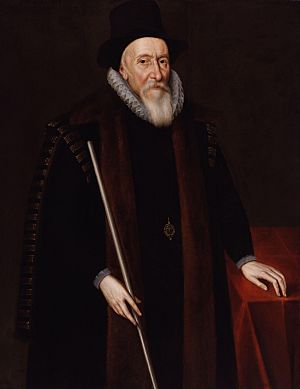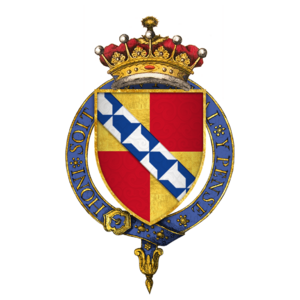Thomas Sackville, 1st Earl of Dorset facts for kids
Quick facts for kids
The Earl of Dorset
|
|
|---|---|

Portrait by John de Critz
|
|
| Lord High Treasurer | |
| In office 15 May 1599 – 19 April 1608 |
|
| Monarch | Elizabeth I James I |
| Preceded by | The Lord Burghley |
| Succeeded by | The Earl of Salisbury |
| Personal details | |
| Born | 1536 Buckhurst, Sussex Kingdom of England |
| Died | 19 April 1608 (aged 71–72) Westminster, London Kingdom of England |
| Spouse | Cicely Baker |
| Children | 7, including Robert and William |
| Parents | Richard Sackville Winifred Brydges |
Thomas Sackville, 1st Earl of Dorset (born 1536 – died April 19, 1608) was an important English leader, a poet, and a writer of plays. He was the son of Richard Sackville. He was also a cousin to Anne Boleyn, who was a queen of England. Thomas Sackville served as a Member of Parliament and later as the Lord High Treasurer, managing the country's money.
Contents
Life and Times
Early Years and Education
Thomas Sackville was born in a place called Buckhurst, in Sussex, England. His mother, Winifrede, was the daughter of a former Lord Mayor of London.
He went to college at St John's College, Cambridge and Hertford College, Oxford. He earned a master's degree. After college, he studied law at a famous legal school called the Inner Temple. He then became a lawyer.
Starting in Politics
Thomas Sackville began his political career in 1558. He was chosen to represent Westmorland in the House of Commons, which is like a part of today's Parliament. He later represented other areas too.
In 1566, Sackville traveled to Rome. He was held there for two weeks, but the exact reason is not clear. At that time, there was a lot of tension between England and the Pope. His father passed away that same year, and Thomas returned home.
Becoming a Lord and Diplomat
In 1567, he was given the title of Baron Buckhurst. This meant he became a lord. His first big job for Queen Elizabeth was in 1571. He went to France to congratulate the French King on his marriage. He also helped discuss a possible alliance between Queen Elizabeth and the Duke of Anjou.
In 1572, he was one of the lords who helped with the trial of Thomas Howard, 4th Duke of Norfolk. Later, in 1586, he was chosen to tell Mary, Queen of Scots, that she had been sentenced to death by the English Parliament.
Challenges and Honors
In 1587, he became an ambassador to the United Provinces. This was because they had complaints against the Earl of Leicester. Even though Sackville did his job well, the Earl of Leicester was powerful. He managed to get Sackville called back to England. When he returned, he was kept at his own house for several months. Queen Elizabeth was not happy with his "shallow judgment in diplomacy."
However, he was not out of favor for long. In 1588, he received a very special honor, the Order of the Garter. He was sent to the Netherlands again in 1589 and 1598 for more diplomatic work.
High Office and Later Life
In 1591, Sackville was chosen as the head of the University of Oxford. In 1599, he took over as Lord Treasurer after William Cecil, Lord Burghley died. This was a very important job, managing all the country's money. He was good at this job and kept it until he died. In 1601, he was involved in the trial of the Earl of Essex, who had been his political rival.
When King James I became king in 1603, he kept Thomas Sackville as Lord Treasurer. In 1604, King James gave him an even higher title: Earl of Dorset.
Thomas Sackville owned several important homes. These included Knole House in Kent and Michelham Priory in East Sussex. He also owned Dorset House in London, which later burned down in the Great Fire of London.
In 1607, Thomas Sackville became ill. The King sent him a special ring with diamonds as a gift. The King hoped Sackville would live as long as the diamonds lasted. Sackville recovered for a while and wrote his will. He passed away suddenly on April 19, 1608, while at a council meeting. He was buried in the Sackville family vault in Withyham Parish Church.
Literary Works and Business
Besides his political work, Thomas Sackville is also known for his writing.
Plays and Poetry
In 1561, he co-wrote the play Gorboduc with Thomas Norton. This was the first English play written using blank verse, which is poetry without rhymes. The play was about the problems that can happen when there is political rivalry. It was performed for Queen Elizabeth.
He also wrote a poem called Complaint of Henry, Duke of Buckingham for a book called The Mirror for Magistrates in 1563. Sackville's most famous poem is Induction. It describes a journey to dark, scary places where the poet meets figures that represent suffering and fear. This poem is known for its strong allegory and serious, grand style.
Business and Armor
Thomas Sackville became very wealthy from buying and selling land. He also invested in the iron foundry business, which made metal products.
He believed in strict rules about what clothes people could wear, especially in the military. These rules were called sumptuary laws. He said that only high-ranking officers should wear silk and velvet. Lower-ranking soldiers should wear simpler fabrics and spend their money on weapons instead.
Around 1587, Sackville was allowed by the King to order a special suit of armor. This armor was made in the royal workshops at Greenwich. It was beautifully decorated with etchings, bluing, and gold. This armor is one of the best examples of armor from that time and is now in the Wallace Collection in London.
Family Life
In 1555, Thomas Sackville married Cicely Baker. She was the daughter of an important politician, Sir John Baker. They had seven children together. Their eldest son, Robert, inherited his father's title. Another son, Sir William Sackville, became a knight.
One of their daughters, Anne, married Sir Henry Glemham. Another daughter, Mary, married Lord Bergavenny. People at the time noted that his daughters were very well-educated and talented.
See also
 In Spanish: Thomas Sackville, I conde de Dorset para niños
In Spanish: Thomas Sackville, I conde de Dorset para niños



